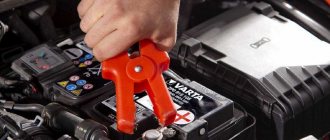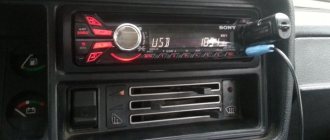Often owners of VAZ 2106 - 2107 wonder why the battery indicator light does not light up when the ignition is turned on . This is a fairly common problem on classic. And almost everyone has encountered such a manifestation of a malfunction in the car’s energy system.
And it’s one thing if such a malfunction occurs in the summer and 100 meters from the house. Such a breakdown is much more dangerous in cold weather on a country road, especially at night. Therefore, you need to know the causes of the problem, as well as how to fix it. There are several reasons for a light bulb to fail. You'll have to check all the options, fortunately it's not difficult. Basic electrical knowledge is sufficient.
Burnt out battery indicator light
A fairly common cause of this problem is lamp failure. This is perhaps one of the simplest breakdowns, but it is not always harmless. It is advisable to replace the light bulb as quickly as possible. If there are problems with it, you will not be able to identify the problem with the generator in a timely manner. Which will lead to the battery being discharged at the most inopportune time. Thus, driving with a burnt-out lamp is highly not recommended.
Battery charge indicator light VAZ
You should also consider the design features of your car. Most generators have a built-in resistance. This allows you to generate energy even when the charge control lamp is burnt out. On some cars, the lamp itself plays the role of resistance.
This can be found on some modifications of the VAZ 2112, as well as many old foreign cars. In this case, when the light bulb burns out, the generator stops producing current. If your car has this structure, you should always have a spare lamp.
We are looking for problems - the main culprits of the voltage drop
The problem is that your car may have a number of individual problems that lead to a drop in voltage. Therefore, only a specialist can tell the reason one hundred percent after examining the entire electrical circuit and performing high-quality diagnostics. Without inspecting the car, you can only guess the real problems and speak in general terms. However, there is a certain set of blocks and equipment that is responsible for voltage. This is what you should check first:
- battery - if this device is completely discharged, the computer tries to replenish its resources and sends the lion's share of the generated energy to charge and restore it;
- generator - a broken diode bridge can cause a significant drop in network performance, and this will cause problems with the battery in the future;
- voltage regulator (tablet) - installed on the generator and distributes voltage flows from this device; if it breaks, it can put an excessive load on the engine;
- too powerful equipment - for example, you could install a sound amplifier and subwoofer that the on-board electrical system of your car simply did not support;
- a failed consumer of electrical energy - this could be a burnt-out fan, a broken fuel pump, failed headlights, an air conditioner and other components.
Of course, this is not a complete list of possible causes of problems. It is worth remembering the importance of proper operation of the electrical network. In case of malfunctions and constantly low voltage, a variety of troubles are possible, including burning of important parts and simply low reliability of the vehicle as a whole. So it’s not worth driving with such a problem for a long time. You should immediately send the car to a service station or perform independent diagnostics.
Low battery
Another common reason why the battery warning light does not light up when the ignition is turned on in a VAZ 2106 - 2107 is a weak battery.
If, at the same time that the battery light does not light up, the dashboard instruments do not turn on or are dimly lit, then this is a clear sign of a low battery. The problem can be “cured” by simply charging the battery.
Good battery
However, not all so simple. The discharge of a car battery may not occur because the owner did not have time to charge it in time or forgot to turn off the headlights. A problem with a battery becomes dangerous if the cause lies in the generating device. As you know, the battery must be charged while the car is moving, otherwise it will discharge quite quickly. And this function falls on the generator. But if the latter is faulty, then problems arise.
Thus, a seemingly trivial reason may indicate a damaged car generator, which performs many useful functions. Obviously, a thorough diagnosis should be carried out, the cause should be found and eliminated.
Indicator light
As can be seen from the diagram, the charging system involves a large number of components and each of them can cause poor charging or its absence. To monitor the battery charging process, the car's dashboard is equipped with a control light.
If the system is in good working order, the control signal turns on after the factory. But when the engine enters operating mode, the VAZ 2107 battery charging light does not light up. This means that the battery's energy supply is replenished from the generator. At the same time, the needle on the voltmeter moves to the green sector.
Signs of a battery not charging:
- The VAZ 2107 battery charge arrow twitches.
- The control signal does not go out. In some cases, the VAZ 2107 battery light blinks.
- The voltmeter needle does not go to the green zone after starting the engine.
- When the engine is running, the voltage on the battery should remain around 13.9.
- The permissible deviation in any direction does not exceed 0.3 V. Undercharging of the VAZ 2107 battery within these limits is not yet dangerous.
A voltage drop to 12 V says: the generator is not charging! lamp is dimly lit - the battery is undercharged.
Blown fuse
A failed dashboard light may be caused by a blown fuse. In this case, several devices usually fail at once. If such a symptom appears, you just need to check the fuse. It is located in the mounting block.
Mounting fuse block VAZ 2107
You can find it using the diagram on the block cover. To check, the fuse is removed from the mounting block. The easiest way is to install a known good fuse. If this is the reason, then the light should light up when the ignition is turned on. You can also check the fuse by measuring the resistance with a multimeter.
Where to start checking
If the VAZ 2107 battery icon does not light up, the voltmeter gives normal readings, but the battery does not charge, which means there is no (or insufficient) contact at the terminals. Their severe oxidation can cause the voltage from the generator to the battery simply not to flow. Therefore, it is necessary to remove the terminals, thoroughly clean them, as well as the battery terminals, then reconnect the battery to the on-board network and check the functionality of the charging system.
In the case when the voltage on the VAZ 2107 battery is still below normal, you need to measure it at the output from the generator with the engine running. Is there a big difference between the readings on the terminal and on the battery? Try cleaning the contacts and checking the wire connecting the battery to the generator. Broken - requires replacement.
The next element that is checked is the generator drive belt. If it becomes loose, it will slip along the pulley, which is why the generator will not be able to generate the required amount of electricity. And although charging will be carried out (provided the circuit is in good condition), it will not be enough. At the same time, the engine is running, the voltmeter shows the norm. However, if the system is loaded a little more - for example, by turning on the headlights - then the voltage drops sharply. Then, if the battery charge on a VAZ 2107 disappears, this indicates that the tension belt is loose and slipping. The belt should be tightened; if it wears out during operation, replace it. But you can’t overtighten either: excess belt tension puts an overload on the pumps and generator bearings.
The third component of the circuit that is checked during the initial diagnosis is fuse No. 10 (in the fuse box). It is he who is responsible for supplying voltage to the battery: the VAZ 2107 battery charging fuse has blown - the system will not work.
If everything is in order with the terminals, belt, fuse, the reasons for poor charging of the VAZ 2107 battery need to be looked for further.
A light bulb may burn out due to a faulty electrical circuit.
A problem with the circuit that powers the battery light can be caused by several things. Let's consider everything.
So, problems with contacts are becoming quite common. Usually this situation occurs in the spring, after cold weather. During the winter months, moisture accumulates on the connectors, causing the formation of oxides. This makes the contact much worse, as a result of which the indicator stops turning on.
Electrical circuit diagram of VAZ 2107
As a rule, this problem does not appear immediately and is not stable. In other words, the light bulb may light up one time and not another time. The solution to this problem is to clean all connectors. They should be treated with a grease specifically designed for this purpose.
The light bulb may burn out due to an open circuit. To make sure of this, you should arm yourself with a multimeter. The device checks the circuit to determine the faulty section.
Fuse relay is faulty
Another possible problem is a faulty relay. Some car modifications are equipped with a relay that monitors the battery charge light on the instrument panel. As soon as the relay fails, the indicator does not work either.
Fuse relay VAZ 2107
To test the relay, you should arm yourself with a multimeter. They measure the current at the positive output of the relay. If the voltage is less than 6V, then there is clearly a problem with the generating device. If the value is even higher, then the relay is faulty. It needs replacing.
Thus, finding out the reason why the battery light does not light is extremely important for adjusting the indicator and protecting the car from more serious malfunctions.
Design of a car generator
Any generator, with the exception of direct current models, creates multiphase alternating current - three or four phases, depending on the power. Why such a complication if the on-board network uses only direct current anyway? The fact is that a multiphase alternating current generator has higher efficiency, and most importantly, the current is removed not by brushes from the rotating rotor, but from the stationary stator windings. Accordingly, there are no problems with burnout of the collector (the current in it is much less than what the generator produces), and the collector itself is simpler - two rings, and not a set of insulated lamellas.
To convert polyphase alternating current into direct current, a diode bridge is used. At a minimum, it contains several powerful diodes with twice the number of phases - they are engaged in rectifying the current. Some generators also have additional diodes that provide power to the relay regulator.
The relay-regulator itself is no longer a relay: instead of an electromechanical device, electronic circuits are used to control generators, but the name “relay-regulator” has already firmly established itself behind it. They operate in the same way - by changing the current in the rotor winding (and the magnetic field in the core), they increase or decrease the voltage at the generator output so as to keep it within specified limits from 13.7 V (old low-power generators) to 14.5 V (modern generators designed for high power consumption of the on-board network and accelerated battery charging). Modern generators are no longer independent units, but are integrated with on-board controllers: the ECU controls the voltage, raising it after the engine starts to speed up battery charging, and then lowering it to normal.
The relay-regulator is powered from an external network (Zhiguli, most foreign cars) and from the generator itself through additional bridge diodes (front-wheel drive VAZs). The second circuit is considered less reliable, but has a distinctive ability to self-excite due to the residual magnetization of the rotor - the generator, spun up to high speeds, produces enough current for the relay-regulator to operate and bring it to operating mode.
Checking fuses of VAZ 2106 - 2107 with a multimeter
You also need to know how to check a fuse in a car with a multimeter because in some cases replacing it does not eliminate the malfunction; the circuit needs a more thorough check. Usually its failure is visible to the naked eye, but in some cases the break can be detected only after an instrumental check. To do this, use a car tester or even a simple voltmeter to measure direct current.
- We attach the probes to the fuse.
- Next, using simple manipulations, we melt the wiring inside the fuse. Therefore, we made a non-working fuse out of a working fuse. What won’t you do for a good article!? :-). Again we apply the probes to the fuse and look at the behavior of the multimeter.
- The resistance is infinitely large, we do not hear any sound signal like “peep”. The fuse is broken. It can be thrown into the trash bin.











